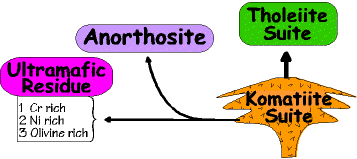|
Archaean Komatiite Suite
The Archean is the oldest phase of earth history, and it often produced rocks rare or non-existent later in history. Archean oceanic lithospheric rocks tend to be rare today, since they would subduct, but the preserved examples we do have consists of interlayered amphibolites (medium grade metamorphosed ultramafic igneous rocks) (often pillowed) and anorthosites (Ca rich plagioclases), sometimes with nickel and chromium rich layers (Windley, 1984).The close spatial and chemical association of these rocks points to a common origin of fractional crystallization of an ultramafic (komatiite) parent at an oceanic rift system. During fractionation highly refractory components such as nickel, chromium and olivine crystallize out and settle to the bottom of the magma chamber forming the bottom of the Archean oceanic lithosphere.  To understand these rocks we have to go back to the earth's origins. In the beginning the earth was a red-hot molten ball, rich in ultramafic materials (the parent material), including large quantities of silica, iron, and calcium. High density materials sink toward the center, and the surface is a magma ocean cooling and solidifying to a lithosphere of gabbros, basalts and anorthosites. (You have to close your eyes and imagine flying past the earth about 4.2 billion years ago; it is a bubbling, seathing hot ball of red magma everywhere. It is also a planet devoid of intermediate or felsic igneous rocks, continental blocks, or sedimentary and metamorphic rocks.) In the mantle turbulent convection cells form and convect heat to the surface via rising plumes of plastic rock. A few tens of kilometers below the surface reduced pressure leads to melting, and subcrustal ponding of ultramafic magmas. Some of the magma escapes to the surface as volcanoes, and the magma chamber begins a cooling phase. During the cooling, fractional crystallization occurs as geologic processes physically separate the various fractions into layered igneous rocks of ultramafics, anorthosites, and mafic volcanics. |